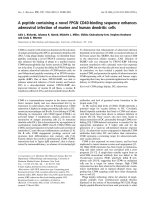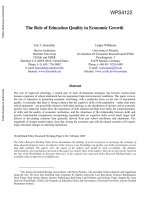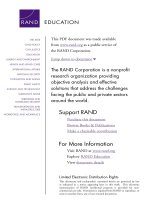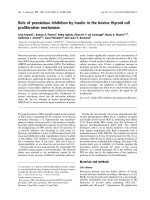THE ROLE OF DMSO IN THE REGULATION OF IMMUNE RESPONSES BY DENDRITIC CELLS
Bạn đang xem bản rút gọn của tài liệu. Xem và tải ngay bản đầy đủ của tài liệu tại đây (2.57 MB, 166 trang )
THE ROLE OF DMSO IN THE REGULATION OF
IMMUNE RESPONSES BY
DENDRITIC CELLS
ELAINE LAI MIN CHERN
(B.Sc (Hons), NUS)
A THESIS SUBMITTED FOR
THE DEGREE OF MASTER OF SCIENCE
DEPARTMENT OF MICROBIOLOGY
NATIONAL UNIVERSITY OF SINGPAPORE
2010
ACKNOWLEDGEMENTS
I would like to express my heartfelt gratitude to Assoc. Prof. Lu Jinhua for his dedicated
supervision and encouragement throughout the project. His advice and concerns beyond
academic and research were and will be always treasured.
I would also like to take this opportunity to thank my friends and colleagues in the
laboratory for their help, support and friendship during the course of my research.
Special thanks to Boon King for the primers used in real time PCR. My gratitude also
goes to the staffs at the National University Hospital Blood Bank and Blood Donation
Centre for their help in buffy coat preparations.
Lastly, I am ever grateful to my parents and husband, Jack Sheng for their care and
support given unconditionally throughout my Master studies.
I
TABLE OF CONTENTS
Acknowledgements
I
Table of Contents
II
Summary
VII
List of Tables
VIII
List of Figures
IX
List of Abbreviations
XI
Chapter 1 Introduction
1.1
The Immune System
1
1.2
Innate Immunity
1.2.1
Overview of Innate Immunity
4
1.2.2
Myeloid Cells Form a Major Arm of Innate Immunity
5
1.2.2.1
Monocytes
6
1.2.2.2
Monocytes Differentiation
8
1.2.2.3
Macrophages
10
1.2.2.4
Dendritic Cells
17
1.2.2.5
Heterogeneity of Dendritic Cells Subsets
18
1.2.2.6
DC Maturation and Migration
23
1.2.2.7
DCs in antigen uptake, processing and presentation
26
1.2.2.8
In vitro Human DC Differentiation Models
29
1.2.3
Pattern Recognition Receptors
30
1.2.3.1
Phagocytic Receptors
31
1.2.3.2
Toll-Like Receptors (TLRs)
33
II
1.2.3.2.1
TLRs and their ligands
35
1.2.3.2.2
TLR signaling
42
1.3
Adaptive Immunity
1.3.1
Overview of Adaptive Immunity
44
1.3.2
Th1 Immunity
48
1.3.2.1
Effectors of Th1 Immunity
49
1.3.3
Th2 Immunity
50
1.3.3.1
Effectors of Th2 Immunity
50
1.3.4
Th17 Immunity
51
1.3.4.1
Effectors of Th17 Immunity
52
1.4
Dendritic Cells in Th1, Th2 and Th17 Induction
52
1.5
Dimethyl Sulfoxide (DMSO)
57
1.6
Aims of Study
60
Chapter 2 Materials and Methods
2.1
Materials
62
2.1.1
Bacteria Culture and Preparation
62
2.2
Buffers and Media
62
2.3
Cell Culture Techniques
63
2.3.1
Isolation of Human Peripheral Blood Monocytes
63
2.3.2
Isolation of CD4+ T Cells
64
2.3.3
Monocyte Differentiation – Macrophage and DC Culture
64
2.3.4
Cell Lines Culture
65
2.3.4.1
THP-1
65
2.3.4.2
Human Embryonic Kidney 293T Cells (HEK293T)
65
III
2.3.4.3
Cryopreservation of Cell Lines
66
2.3.4.4
Thawing of cryopreserved cells
66
2.3.5
Priming and Activation of Monocyte, Macrophage and DC
66
2.3.6
Generation of anti-CD3/anti-CD28 coated beads
67
2.3.7
Mixed Leukocyte Reaction
68
2.4
Immuno-Detection of Proteins
68
2.4.1
Western Blotting
68
2.4.2
Protein Stripping from Western Blot
69
2.4.3
Flow Cytometry Analysis
69
2.4.3.1
Detection of Surface Proteins
69
2.4.3.2
Detection of Intracellular Proteins
70
2.4.3.3
Detection of Intracellular Cytokines
70
2.4.4
Cytokine Assay – ELISA
71
2.5
Protein Chemistry and Electrophoresis Techniques
72
2.5.1
SDS-Polyacrylamide Gel Electrophoresis
72
2.5.2
Coomassie Brilliant Blue Staining
73
2.5.3
Silver Staining
73
2.5.4
Quantification of Protein Concentration – Bradford Assay
74
2.6
Molecular Biology Techniques
74
2.6.1
Polymerase Chain Reaction
74
2.6.2
Real-time PCR
76
2.6.3
Isolation of Total RNA
77
2.6.4
Quantification of RNA
77
2.6.5
Reverse Transcription and cDNA Systhesis
77
2.6.6
DNA Agarose Gel Electrophoresis
78
IV
2.7
Histone Study Techniques
79
2.7.1
Cell Lysis
79
2.7.2
Acid Extraction of Histones
79
2.7.3
SDS-Isolation of Histone Proteins
80
2.8
Cell Death Assessment – LDH Assay
80
2.9
Statistical Analysis
81
Chapter 3 Results
3.1
Overview
82
3.2
Monocytes differentiate into Macrophages and DCs
83
3.3
DMSO Effect on Cytokine production by Macrophages and DCs
86
3.4
Time and Concentration Dependent Effect on DMSO on DCs
89
3.5
DMSO Treatment Effect on Cell Survival
93
3.6
DMSO Effect on Cytokine Production by GM-DC is reversible
95
3.7
DMSO Effect on GM-DC Maturation
97
3.8
DMSO does not affect the morphology of DCs
99
3.9
DMSO Enhances Th1 Type Immune Response induced by GM-DC 101
3.10
DMSO Effect on Histone Expression and Histone Modifications on DCs
106
3.11
DMSO Effect on CD4+ T Cell
109
3.12
DMSO Effect on Cytokine Production by CD4+ T Cells in MLR
111
3.13
DMSO Effect on Cytokine Production by CD4+ T Cells in Intracellular
Cytokine Production
115
Chapter 4 Discussion
V
4.1
DMSO primes APCs towards a Type I Immune Response
117
4.2
DMSO effect is concentration dependent
119
4.3
DMSO does not affect cell survival
120
4.4
DMSO does not affect cell morphology and DC maturation
121
4.5
DMSO Effect on cells is reversible
122
4.6
DMSO primes GM-DC to favour a Th1 Type of Immune Response 123
4.7
DMSO and Histone modifications
125
4.8
Conclusion and Future work
126
References
128
VI
SUMMARY
Dimethyl sulfoxide (DMSO) is a common agent for cryo-preservation despite its known
toxicity. Dendritic cells (DCs) are potent in antigen uptake when immature, but become
potent antigen presenting cells (APCs) upon maturation. Macrophages (MFs) are
professional phagocytes. DMSO primed macrophages and DCs displayed differential
cytokine production when stimulated with IFN-γ/LPS. DMSO primed DCs showed
significant up-regulation of IL-12 and down-regulation of IL-10 production upon IFNγ/LPS stimulation. IL-23 production by DCs was also up-regulated by DMSO priming.
Macrophage displayed a more tolerogenic profile and was not as responsive in response
to DMSO priming unless GM-CSF was used to differentiate macrophages derived from
monocytes. Cellular viability, morphology, antigen and maturation markers were not
affected by DMSO priming. This study investigates the regulation of immune responses
by DMSO primed DCs and how DMSO affects DCs in the cytokine production,
morphology, and the ability to activate naive T cells to mount an adaptive response.
VII
LIST OF TABLES
1.1
Comparison of Innate and Adaptive Immunity
3
1.2
Comparison of DC subsets
22
1.3
Phagocytic receptors for microbes
33
1.4
TLRs
41
2.1
Reagents for SDS-PAGE
72
2.2
Primers used in PCR
76
VIII
LIST OF FIGURES
1.1
The mononuclear-phagocyte system
8
1.2
Monocyte Differentiation into Macrophage and DCs
9
1.3
The ontogeny of Monocyte and Macrophage
11
1.4
Factors regulating the activation of various macrophages
16
1.5
The development, differentiation and maturation process of DCs
21
1.6
DC Maturation
25
1.7
Receptor and signaling interactions during phagocytosis
32
1.8
Signaling pathways for TLRs
43
1.9
Major pathways in the regulation of T cells development with the Th2
phenotype.
1.10
56
The role of cytokines in differentiation and effector functions of Th1, Th2 and
Th17 cells.
56
3.1
Phenotypic markers on monocytes, macrophages and DCs
85
3.2
Figure 3.2 DMSO enhances LPS-elicited IL-12p70 production but suppresses
LPS-elicited IL-10 production
3.3
DMSO increased IL-12p70 production by GM-DCs in a dose- and timedependent manner
3.4
88
90
DMSO inhibits IL-10 production by GM-DCs in a dose- and time-dependent
manner
92
3.5
Determination of DMSO toxicity by LDH release assay
94
3.6
DMSO effect on cytokine by GM-DCS is lost upon removal of DMSO
96
3.7
DMSO does not alter expression of cell surface markers
98
3.8
DMSO does not affect GM-DC morphology
100
IX
3.9
Real-time PCR detection of cytokine mRNA in DMSO-primed GM-DCs 103
3.10
DMSO regulation of DC cytokine production
3.11
Western blot analysis of DMSO- and IFN-g/LPS-induced histone H3
104
methylation, acetylation and phosphorylation in GM-DCs
108
3.12
Direct DMSO Effect on T Cell Activation
110
3.13
DMSO Effect on T Cells Activation
113
3.14
DMSO Effect on T Cells Activation (Re-stimulation)
114
3.15
DMSO effect on IFN-γ and IL-17 production by CD4+ T cells (Intracellular
cytokine staining)
116
X
LIST OF ABBREVIATIONS
Nucleotides containing adenine, thymine, cytosine, and guanine and abbreviated as A,
T, C, and G respectively. Other abbreviations employed are listed as below in
alphabetical order.
Ab
Antibodies
Ag
Antigen
APCs
Antigen presenting cells
ATP
Adenosine triphosphate
BCR
B cell receptor
BSA
Bovine serum albumin
CD
Cluster differentiation
CHO
Chinese Hamster Ovary
CLA
Cutaneous lymphocyte-associated
CMV
Cytomegalovirus
CR
Complement receptor
CRP
C reactive protein
Da
Dalton
DC
Dendritic cell
DC-LAMP
DC-lysosome-associated membrane protein
DMEM
Dulbecco’s Modified Eagle Medium
DMSO
Dimethyl sulfoxide
DNA
Deoxyribonucleic acid
dNTP
Deoxyribonucleic triphosphate
XI
DTT
Dithiothreitol
EDTA
Ethylenediaminetetraacetic acid
ERK
Extracellular-signal-regulated kinase
FITC
Fluorescein isothiocyanate
g
Gram
GATA
Trans-acting T-cell-specific transcription factor
GM-CSF
Granulocyte macrophage colony-stimulating factor
HEK
Human embryonic kidney
HI
Heat-inactivated
hr
hour
IFN
Interferon
Ig
Immunoglobulin
IL
Interleukin
im
Immature
IRAK
IL-1 Receptor Associated Kinase
IRF
Interferon regulatory factor
JNK
C Jun N-terminal Kinase
KDa
Kilodalton
LBP
LPS binding protein
LDH
Lactate dehydrogenase
LPS
Lipopolysaccharide
LTA
Lipotechoic acid
M
Molar
MAPK
Mitogen activated protein kinase
MBL
Mannose binding lectin
XII
M-CSF
Macrophage colony-stimulating factor
MF
Macrophage
MHC
Major Histocompatibility Complex
min
Minute
ml
milileter
MLR
Mixed lymphocyte reaction
MMLV
Moloney murine leukemia virus
MR
Mannose receptor
mRNA
Messenger RNA
MyD88
Myeloid differentiation primary response gene 88
NF-κB
Nuclear factor-kappa B
ng
nanogram
NK
Natural killer
nm
Nanometer
NOD
nucleotide-binding oligomerization domain
NP-40
(octylphenoxy)-polyethoxyethanol
OD
Optical density
OSA
2’-5’-oligoadenylate synthase
PAGE
Polyacrylamide gel electrophoresis
PAMPs
Pathogen-associated molecular patterns
PBMCs
Peripheral blood mononuclear cells
PBS
Phosphate buffered saline
PCR
Polymerase chain reaction
PE
Phycoerythrin
PFA
Paraformaldehyde
XIII
PGE
Prostaglandin E
PGN
Peptidoglycan
PKR
Protein kinase receptor
PRRs
Pattern recognition receptors
PVDF
Polyvinylidene fluoride
RNA
Ribonucleic acid
RT-PCR
Reverse transcriptase-PCR
SAP
Serum amyloid protein
SDS
Sodium dodecyl sulphate
SLE
Systemic lupus erythematosus
SP
Surfactant protein
SR
Scavenger receptor
STAT - protein
Signal Transducers and Activators of Transcription
protein
TAP
Transport associated protein
TBS
Tris-buffered saline
TCR
T cell receptor
TCR
T cell receptor
TEMED
N,N,N’,N’-tetramethylethylenediamine
TGF-β
Transforming growth factor beta
Th
T helper
THP 1
Human acute monocytic leukemia cell line
TIR
Toll-interleukin 1 receptor (TIR)
TIRAP
TIR domain-containing adapter protein
TLRs
Toll-like receptors
XIV
TNF
Tumour necrosis factor
TRAM
TRIF related adaptor molecule
Treg
Regulatory T cells
TRIF
TIR-domain-containing adapter-inducing interferon-β
µl
microliter
µM
micromolar
XV
CHAPTER 1 INTRODUCTION
1.1 The Immune System – An Overview
The immune system is a complex defense system that has evolved to protect
multicellular hosts from pathogenic microorganisms and abnormal cell growth leading
to cancer. The immune system is able to differentiate between self and invading
microorganisms. Once identified, the invading microorganisms or pathogens are
contained, removed or destroyed before any damage could occur to the host. The
immune system has also been recognized as an important defense mechanism against
tumour development and cancer leading to the research and development of
immunotherapy in cancer treatment.
The immune system is built up by a variety of cell types and molecules with distinct but
unique functional properties. Nevertheless, the cells and molecules are able to act in
concert to maintain the integrity of the immune system. Cells of the immune system
originate from their hemapoietic progenitors in the bone marrow. Some cells leave the
bone marrow after they were created, migrate to other sites such as the thymus and
mature into effector cells. Many of the immune cells mature in the bone marrow before
migration to their respective sites in the body where they guard against invading
pathogens. An immune response is established on two fundamental steps: recognition
and response. The two events mutually affect each other. The immune system is able to
detect and recognize a wide variety of foreign pathogens through various receptors. The
important task therefore is to differentiate these foreign pathogens from the body’s own
constituents, distinguishing between self and non-self. In doing so, the immune system
1
will then be able to induce appropriate and yet specific immune responses towards the
specific pathogens.
The immune system in mammals can be classified into two arms: the innate immunity
and the adaptive immunity (Janeway, 1992). Innate immunity is generally conserved
across all species but the adaptive immunity is only found in higher vertebrates
(Medzhitov and Janeway, Jr., 1998). Innate immunity is also known as the natural or
native immunity, referring to the host’s basic resistance to disease that one is born with
and is available at the early stages of infection. The innate immune system consists of
several immunoregulatory components, such as natural killer (NK) cells, phagocytes,
complements and interferons (IFN) (Fearon and Locksley, 1996). The cells that
constitute innate immunity express a restricted number of germline-encoded receptors.
Hence, these cells are able to recognize a wide variety of conserved microbial products
and pathogens (Janeway and Medzhitov, 2002). Adaptive immunity is referred to as
‘acquired immunity’ as it is acquired over time through natural microbial encounters or
vaccination. Adaptive immunity is pathogen specific and possesses immunological
memory which enables a faster and heightened immune reactivity to the same pathogen
on its repeated encounter. In other words, adaptive immunity develops as a response to
infection or vaccination and increases in magnitude and strength with each successive
exposure to the same microorgamism (Abbas et al., 2000). The main effector cells of
adaptive immunity are the T cells and B lymphocytes. These cells are capable in highly
specific antigen detection via a huge repertoire of antigen receptors encoded by somatic
gene recombination (Fearson and Lockley, 1996). The general properties of both innate
immunity and adaptive immunity are summarized in Table 1.1.
2
Table 1.1 Comparison of Innate and Adaptive Immunity
Properties
Innate Immunity
Effector Cells
•
Adaptive Immunity
NK cells, Monocytes, DCs, •
T and B Lymphocytes
Macrophages
Receptors
•
encoded in germline
•
no gene rearrangement
•
conserved
•
encoded by somatic gene
recombinations
•
gene rearrangement
•
massive diversity
Distribution of •
receptors
•
non-clonal
•
clonal
all class of an identical class
•
all cells of a distinct class
Recognition
conserved
•
molecular •
specific molecular structures
patterns
Discrimination
•
of self vs. nonself
Time of Action
•
perfect:
immediate activation
•
delayed activation
Responses
•
cytokines (IL-1β, IL-6)
•
clonal expansion or anergy
•
chemokine (IL-8)
•
IL-2
•
co-stimulatory molecules
•
effector cytokines (IL-4, IL-
selected
over •
evolutionary time
imperfect:
selected
in
individual somatic cells
17, IFN-γ)
Modified from Janeway, Jr. and Medzhitov, 2002
While innate immunity and adaptive immunity are considered as two separate events,
innate immunity and adaptive immunity are closely linked. The activation of innate
immunity will then provide adaptive immunity with information regarding the nature of
pathogenic challenge encountered by the host. This cannot be done by the T and B
lymphocytes although T and B lymphocytes possess great variability in antigen
recognition. This explains the occurrence of adverse immune response in autoimmune
3
diseases, allergy and allograft rejection. The antigen presenting cells (APCs) of innate
immunity provide the activating signals through regulation of the surface expression of
their co-stimulatory molecules such as CD80, CD86 and CD40. Monocytes,
macrophages and dendritic cells (DCs) constitute the APCs with DCs playing the most
important role in antigen presentation (Banchereau and Steinman, 1998) as DCs are
known to be potent activators of T cells. The adaptive immunity will respond and
enhance the effector mechanisms of innate immunity to efficiently eliminate the
invading microorganisms. For example, the T cells activated by DCs antigen
presentation will produce and secrete effector cytokines that will in turn activate
macrophages and DCs to mount a stronger response towards the invading pathogen.
Hence, the host is protected from the invading foreign microorganisms via the effective
interplay of the both arms in the immune system.
1.2 Innate Immunity
1.2.1 Overview of Innate Immunity
The innate immunity is known as the front line of host defence against invading
pathogens. It is an ancient and universal host defence system (Janeway Jr. et al., 2002).
The innate immune system alone is often sufficient to clear the source of infection
before a disease develops. The immune mechanisms are able to act immediately because
they do not require clonal expansion of antigen specific lymphocytes as the adaptive
immunity does. However, the activation of innate immunity does not lead to
immunological memory (Janeway Jr., 2002). The other important function of innate
immunity is to process and present captured antigens for the stimulation of adaptive
immune responses. The innate immunity relies on a set of germ-line encoded receptors
to recognize the conserved molecular patterns in specific classes of microorganisms
4
(Medzhitov, 1998). The advantage of having a non-clonal immune system is that it
enhances the adaptive immunity by delaying the need of activating adaptive immunity
while the effector lymphocytes expand and differentiate (Janeway Jr. and Medzhitov,
2002).
The innate immune system is mainly made up of mechanical, chemical and cellular
components (Basset et al., 2003). The mechanical components of the innate immunity
consist of epithelial cells and the mucosal fluid that form a physical barrier to prevent
entry of infectious pathogens. The chemical components of innate immunity are further
classified into three subcomponents: (i) fatty acids, proteins, peptides, and enzymes that
can cause lysis of microbial pathogens; (ii) pattern recognition molecules such as cell
surface receptors or soluble molecules; and (iii) cytokines and chemokines regulating
immune responses. Lastly, the cellular components refer to all the cells that play an
active role in innate immunity. These cells include epithelial cells, eosiniphils, DCs,
mast cells, phagocytic cells, NK cells and γδ T cells. The natural flora and fauna found
in the host’s body also form the innate immune system. Together, these components
identify, contain and remove the invading pathogen.
1.2.2 Myeloid Cells form a Major Arm of Innate Immunity
The cellular component in innate immunity formed by myeloid cells is a major arm of
the innate immune system. The generation of immune cells through hematopoiesis is
divided to lymphopoeisis which generates the lymphocytes and myelopoiesis. Myeloid
cells include neutrophils, eosinophils, basophils, and monocytes which originate from
the myeloid progenitor.
5
1.2.2.1 Monocytes
Haematopoietic stem cells produced by the yolk sac migrate to the foetal liver during
ontogeny and subsequently develop into immature phagocytes (Deimann and Fahimi,
1978). Monocytes appear in foetal blood ciriculation shortly after haematopoiesis begins
(Keleman et al., 1979). Monocytes originate in the bone marrow from the committed
progenitor cells for granulocytes and monocytes. Monocytes share a common myeloid
progenitor, the colony forming unit granulocyte-monocyte (CFU-GM) with the
neutrophils (Metcalf, 1971). The progenitor cells differentiate into monoblasts under the
influence of colony-stimulating factors and then further differentiate into promonocytes,
which is the first morphologically identifiable cells in this line of differentiation (van
Furth and Diesselhoff-Den Dulk, 1970). The promonocytes will then divide into two
daughter monocytes and are released into the blood circulation, circulating in the
peripheral blood. The mononuclear-phagocyte system and the cells differentiation
process are illustrated in Figure 1.1
Circulating monocytes migrate into various tissues and differentiate into tissue
macrophages that possess specific morphological and functional properties according to
the characteristics of the tissues they reside i.e. alveolar macrophages in the lung,
microglia cells in the brain and kupffer cells in the liver. Monocytopoiesis can be
influenced by various growth factors and cytokines. Interleukin 3 (IL-3), granulocyte
macrophage colony-stimulating factor (M-CSF) and macrophage colony-stimulating
factor (M-CSF) stimulate the mitotic activity of monocyte precursors (Jones and Millar,
1989). On the other hand, monocytopoiesis can be suppressed by type-I interferons such
as IFN-α/β (Perussia et al., 1983) prostaglandin E (PGE) (Pelus et al., 1979) and factor
increasing monocytopoiesis (FIM) (Metcalf, 1990). Monocytes were reported to be
6
heterogenous and composed of different subsets (Gordon and Taylor, 2005). Monocytes
were initially identified by their high expression levels of CD14. Differential expression
of CD14 and CD16 (also known as FCγRIII) provided the current basis for the
classification of human monocytes into two subsets: CD14hiCD16- cells which are
known as classic monocytes, and CD14+CD16+ cells which resembles mature tissue
macrophages. It has been shown that monocytes can differentiate into macrophages or
DCs when cultured in the presence of GM-CSF and interleukin-4 (IL-4) (Sallusto et al.,
1994; Sanchez-Torres et al., 2001). There are in vitro transendothelial migration models
showing that CD14+CD16+ monocyte subset was more likely to differentiate into DCs
and reverse transmigrate across the endothelial layer while the CD14hiCD16- monocyte
subset remaining in the sub-endothelial matrix developed into macrophages (Randolph
et al., 1998).
This suggests that the CD14+CD16+ subset might be precursors of DCs, which can pass
through tissues and migrate to the lymph nodes through the afferent lymphatic vessels
(Randolph et al., 2002).
7
Figure 1.1 The mononuclear-phagocyte system Monocytes differentiate from the
HSC-GMCFU in bone marrow and can be further differentiated into macrophages,
dendritic cells, and osteoclast residing in the adult tissues. (Gordon and Taylor, 2005)
1.2.2.2 Monocyte Differentiation
Monocyte production is greatly increased during inflammation and enters the circulation
within 24 hours of their formation (van Furth and Sluiter, 1986). Monocytes circulate
for about 25 hours before extravasation. Monocytes can be activated to differentiate into
macrophages or DCs upon encountering microbial challenge or infection. GM-CSF and
M-CSF are both essential in the production of monocytes and macrophages and both
play an important role in regulating the differentiation of monocytes into macrophages
8
or DCs. GM-CSF and M-CSF can specifically induce the proliferation and
differentiation of monocytes into distinct subsets of macrophages with various
morphology and functions. GM-CSF is pivotal in the development of alveolar
macrophages (Nakata et al., 1991) in the lungs while M-CSF is essential for the
development of tissue macrophages (Cecchini et al., 1994). The differentiation of
monocytes into DCs was originally demonstrated in vitro by Sallusto and Lanzevacchia
in 1994 using monocytes cultured with a combination of GM-CSF and IL-4. Monocyte
differentiation is now found to be a dynamic process dependent on the tissue or
secondary organ that monocytes reside (Chen et al., 2009). For example, monocytes
were able to be differentiated into Th17 immunity polarizing DCs by the blood brain
barrier secreting transforming growth factor-β (TGF-β) and GM-CSF (Ifergan et al.,
2008). Figure 1.2 shows the monocyte differentiation process.
Figure 1.2 Monocyte Differentiation into Macrophage and DCs Figure shows the
three types of macrophages differentiated from the monocyte precursor under different
polarizing conditions. (Auffray et al., 2009)
9









